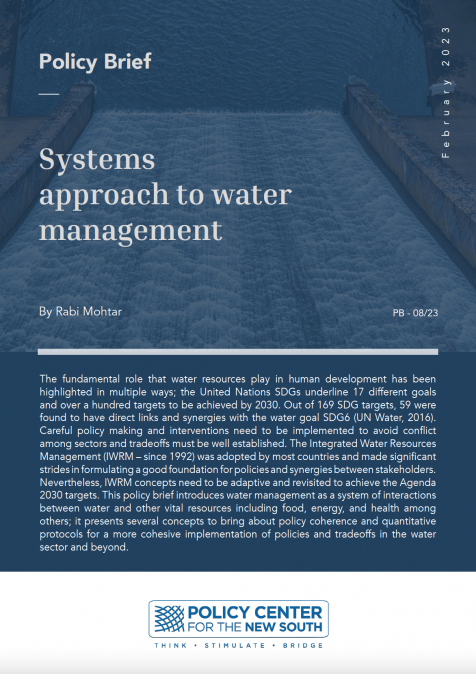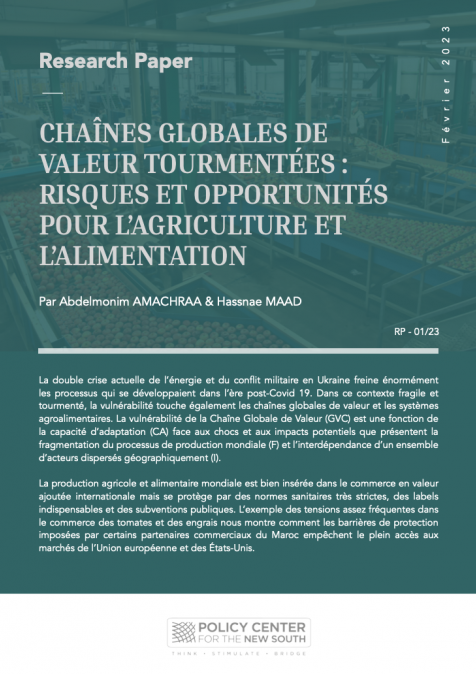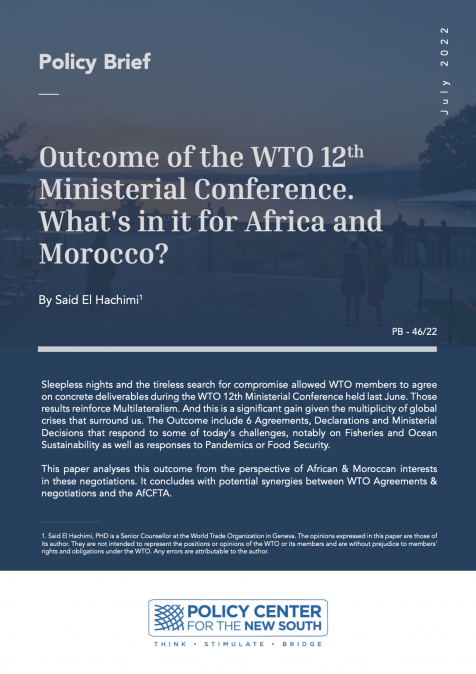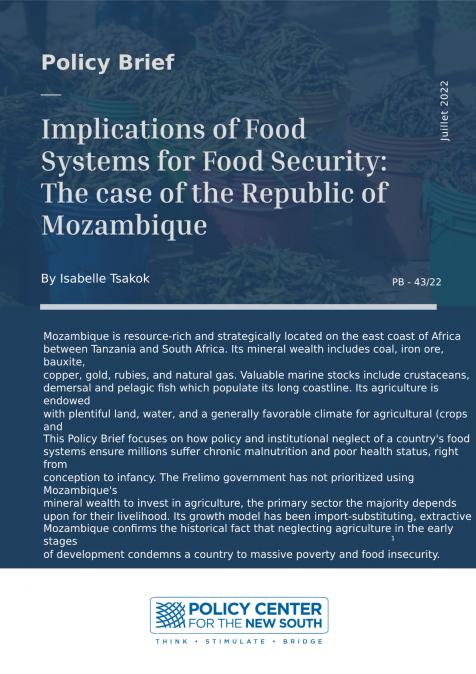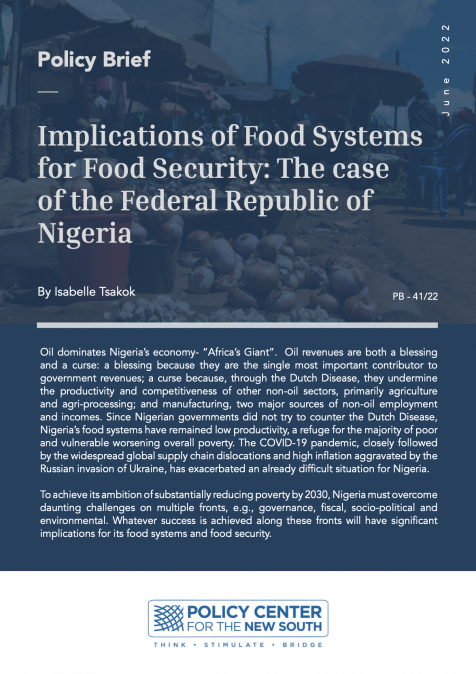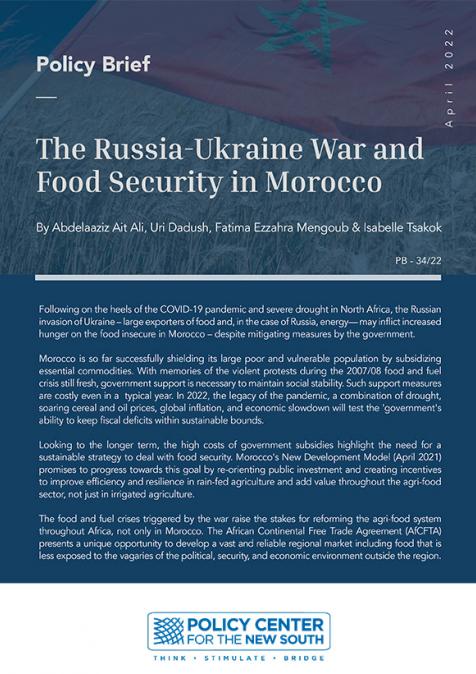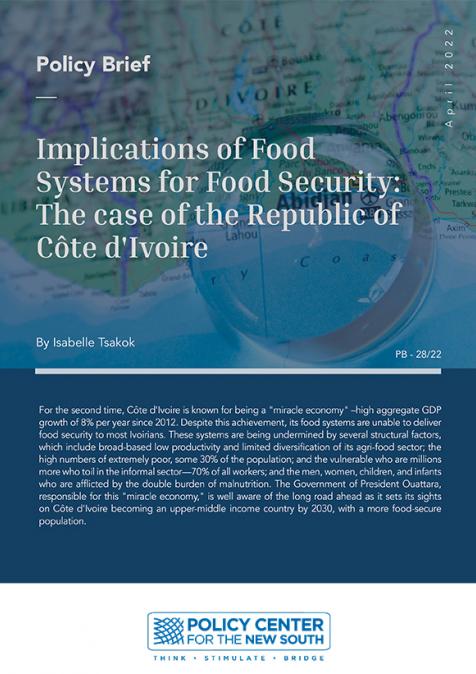Publications /
Policy Brief
The fundamental role that water resources play in human development has been highlighted in multiple ways; the United Nations SDGs underline 17 different goals and over a hundred targets to be achieved by 2030. Out of 169 SDG targets, 59 were found to have direct links and synergies with the water goal SDG6 (UN Water, 2016). Careful policy making and interventions need to be implemented to avoid conflict among sectors and tradeoffs must be well established. The Integrated Water Resources Management (IWRM – since 1992) was adopted by most countries and made significant strides in formulating a good foundation for policies and synergies between stakeholders. Nevertheless, IWRM concepts need to be adaptive and revisited to achieve the Agenda 2030 targets. This policy brief introduces water management as a system of interactions between water and other vital resources including food, energy, and health among others; it presents several concepts to bring about policy coherence and quantitative protocols for a more cohesive implementation of policies and tradeoffs in the water sector and beyond.
1. INTRODUCTION
Water is a resource that is critical for its vital role to support communities and is essential for the entire sustainability and the 17 UN Sustainable Development Goals (SDGs). It supports food production, energy production, health and sanitation, biodiversity (both on terrestrial and aquatic systems) as well as the entire economy of communities.
According to the World Economic Forum (WEF) Global Risk Report (2023), the top 10 global risks in the next 2 years and in the next decade are mostly related to natural resource crises, climate change and other environmental challenges. The burden on natural ecosystems is still growing, as real value of resources does not have the weight it deserves in national economies. According to the WEF report, the lack of significant policy changes toward climate change adaptation and resource securities will accelerate the collapse of ecosystems, making vulnerable economies more prone to water and food insecurity (WEF, 2023).
In addition to this, the geopolitical and economic landscape has also created a multi-crisis effect. As the world still mitigates the economic effects of a global pandemic, wars and political tensions make access to resources in general, food in particular, more defying. For example, the Russian-Ukrainian conflict has compromised the access to wheat imports to highly dependent countries such as Lebanon and Egypt. This conflict has also impacted the global price of wheat (FAO, 2022). Scenarios like this can aggravate the competition for resources; adapting to crises and trying to increase food security in an inefficient way will put more stress in an already fierce competition for water resources in the water-food- energy-health sectors.
The current business model for the allocation of water to various communities in a river basin or among water users is failing and must change. The new model should be based on assigning real water values and creating synergies among users. Such a model will alleviate conflict among users (Mohtar, 2021). Integrated Water Resources Management (IWRM) and other approaches have left inherent gaps that get in the way of cross-sectoral coordination and interinstitutional participation. A more comprehensive platform for the management of water and other resources is a must at the negotiation table in the water-energy- food management decision making, planning and actions. Benefits of this approach are tremendous and encompass economic, ecological, social, ecosystem and political impacts. This policy brief introduces water management as a system of interactions between water and other vital resources including food, energy, and health among others.
Integrated Water Resources Management (IWRM): Basics and beyond
For many years, water management has been a critical path to the efficient use of water resources. Beginning since the 1992 Dublin Conference on Water and Environment (UN Documents, 1992) and the Rio Summit on Environment and Development (UN, 1992), the concept of the Integrated Water Resources Management (IWRM) has been successful in the mission to reconcile multiple and competing sectors that demand water (Smith & Clausen, 2015).
The pillars of the Integrated Water Resources Management include:
-
Enabling environment: including laws and policies that enable cooperation between water users and with local and international river basin communities.
-
Institutional framework: institutions and partnerships at multiple scales, including the planning and governance of water.
-
Management Instruments: such as assessment of water resources and coordination that ensures accountability and the development of organizational capacity for water resources.
-
Financing: integrated management of water must include financing and revenue raising for water services.
Two additional pillars were introduced to the Integrated Water Resources Management in 2015 by Smith and Clausen that include:
-
A dynamic management, which is learning and adaptive, deliverable for complex water systems and social learning, and
-
Bridge strategies that allow for a platform that brings sectors and stakeholders together.
These six pillars have made significant contributions to water resources management the way we know it today.
However, given the complexity of the interlinkages of the water sector and other sectors involved, it is imperative that IWRM adapt and evolve taking into consideration factors such as climate change effects and adaptation, the water-energy-food-health nexus, and the current geopolitical and social developments.
To put this in a global perspective, for example, it is estimated that energy production requires 580 billion cubic meters of freshwater per year; this accounts to 15% of the world’s annual total freshwater withdrawals (IEA, 2023). On the other hand, energy requirements to extract and distribute water can be intensive; just in the United States, water related energy use accounts for 13% of the total national energy consumption per year (Sander and Webber, 2013). Climate change will affect health, economies and ecosystems mainly through water, not only due to reduced access and availability, but also because this will cause increased crop water requirements (direct impact on agriculture), and it will impact water quality as well (Sadoff and Muller, 2009). Water and regional peace are also correlated; water agreements in long standing conflicts have been successful through an integrated outlook of water management. Figure 1, highlights these interlinkages and challenges.
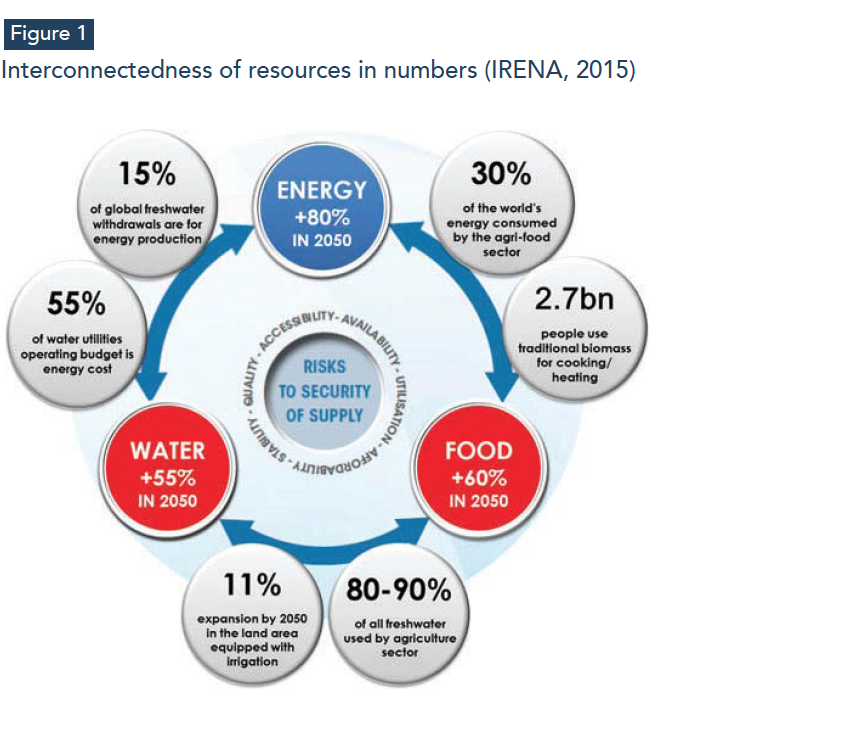
The future challenge for the water community therefore is not only to achieve solutions within the water sector, but water solutions across sectors in an interdisciplinary, complex, and interconnected world. The need for a new vision that creates a platform to engage other players and other users of water beyond the water community is crucial. This policy brief presents a holistic systems approach to manage water that integrates stakeholders from outside the water community and allows for quantification of the trade-offs among sectors.
What is proposed here is not to replace any of the disciplines and knowledge that have been generated over the years by the food, water, and energy disciplines - such as sustainable diets and food production, energy efficiency, and integrated water resources management. These disciplines operate within a complex model where society, government and business, supply chain and politics are impacted by multiple interactions from outside, including dietary related diseases, rising economies, climate change, demography growth, trade, political pressure, technology and resilient environment. Consequently, formulating solutions in such a complex system requires a platform where these interlinkages are being assessed and trade-offs are identified and quantified in order to move forward with solutions that cut across these multiple disciplines.
Evidently, the matter becomes how do we develop these inter linkages and platforms, and how do we foster the trade-offs that allow us to start a dialogue across these sectors, to move away from competition into synergies.
2. CREATING MULTISECTORAL COHERENCE
The new approach explores interlinkages between water and other sectors, in specific, food, energy, health, and other pillars of sustainable development. Addressing such interlinkages in a quantitative and holistic manner is central to achieving synergies between sectors and avoid competition; thus, accelerating the implementation of the SDGs.
Over the years of implementing IWRM, we have learned that the planning, execution and success of water projects must involve the participation of all key stakeholders, beyond the water sector. We also learned that planning works best when appropriate institutional framework is in place. Unfortunately, when talking about this system of systems, there is no institutional framework that governs water resources beyond the water sector. As an example, even though agriculture is a major user of water, the governance of water for agriculture is outside the mandate of the water sector, and it is conferred to the farming community; this creates incoherence in the decision making.
We learned that prevention and preparation are far more beneficial than restoration at a watershed scale, and for that reason, proper planning and a comprehensive water strategy is needed. Effective water management must address the entire hydrologic cycle, and that hydrologic cycle touches on processes outside the traditional water sector.
A further lesson learned is that water management is needed for maintaining a balance between groundwater pumping and recharging. There are countless examples all over the world where aquifers are over pumped and they are not sustainable in terms of their recharge and their use balance.
We also learned that the potential benefits of collaborative water resource management can act as an accelerator for regional cooperation. It is worthy to emphasize the fact that water is not only a resource for consumption, but it can be used as a collaborative resource that brings people together for regional integration. And this is something that has many examples of success in the recent past. The participation of government officials is important in these discussions for galvanizing local political support, for advocacy effort and increasing trust in research findings.
Last but not least, we need to address problems across inter linkages, at the system levels. And that brings about the new vision that we are about to remark on.
As mentioned earlier, the Sustainable Development Goal Number six sits at the core of the 17 other goals, and is an enabler for such a complex system of systems of SDGs. And as such, the approach that is being discussed and proposed here is at the core of these interactions.
The current practices of water management, the way we see them today, lack the analytical methodology to identify holistic solutions and capitalize on synergies between multiple sectors (most importantly, trade-offs). In other words, the sectorial approach has been unsuccessful in addressing the resource allocation from a system level perspective. Single- discipline water management has failed to predict emerging hot spots or regions with impeding resource allocation within complex climate, population and land use changes.
The New Approach
Building on the six dimensions of IWRM mentioned earlier, we here below suggest the addition of four new dimensions that integrate different elements into this complex system. These additional four dimensions involve water at the center of a complex SDGs system, and move away from a unidirectional relationship between water and other resources into a beneficial, mutual relationship among these communities of: water and people, water and food, water and nature, water and industry, water and peace, water and education, water and energy, water and health, water for equity and access. All of these relationships symbolize the connection between water and other sectors, where water impacts these resources and they in return impact water.
These additional dimensions are:
-
Identify sectors that are being impacted and assess the interaction of interlinkages; this implies recognizing the stakeholders that represent these sectors.
-
Identify solutions at the system level, where these solutions may arise beyond the water sector. This must include a quantitative analysis through the application of models to explore different scenarios, based on the exploration of a range of present and future water demand and availability conditions.
-
Engage and train stakeholders for this new systems approach to water management.
-
Identify synergies. The implementation strategy would include definition of hot spots where interventions are needed for water management. The use of decision support systems to simulate and model different scenarios and develop interventions that will make sense; this quantitative analysis must be followed by the assessment of tradeoffs associated with these interventions and identification of solutions and synergies.
Then again, it is essential at the end to communicate these solutions, engage stakeholders for adoption and for capacity building, to accept these solutions and allow for a dialogue at the system level for all involved stakeholders. The interface between science, policy and implementation is not an easy process, because in the past, governance of these resources (including water and others) has been in a sectorial domain; hence developing the framework and the governance structure that allow for intersectoral solutions, communicating these and engaging the stakeholders and coming up system level benefits is very critical.
3. IMPLEMENTATION OF SYSTEMS APPROACH TO WATER MANAGEMENT: The San Antonio, Texas, Water-Energy-Food system
According to the Texas Water Development Board (TWBD), Texas is expected to have a nearly 40% water gap by 2070. The Eagle Ford Shale region encompasses the State’s fastest growing cities in the USA, it has a thriving agriculture sector, and is a major energy producing spot (Mohtar, 2019). San Antonio in particular is a typical example of water- energy-food sectors competing for water without any policy coherence. Rapid growing population put stress on the demand for water for domestic use; in addition, there is major oil and gas production and agricultural activity surrounding the city. Mohtar and Daher (2019) discuss a comprehensive study in which an interdisciplinary group assessed and quantified the San Antonio hotspot (Figure 2); several recommendations and interventions were proposed to reduce existing and projected stresses in the area.
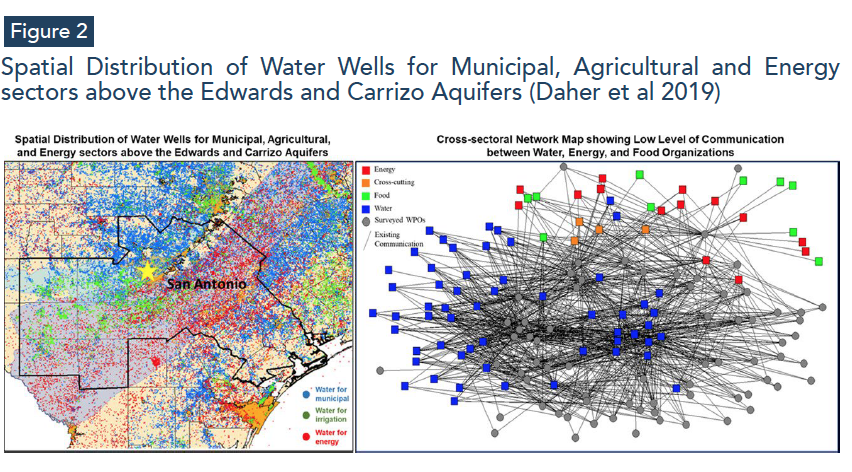
Some of the solutions proposed require major investments in infrastructure, such as increasing the use of treated wastewater and adopting renewable energy technologies. These solutions go beyond the capacity of a typical IWRM regime. Another recommendation was to adopt low impact development (LID) technologies; these structures (in the transportation sector) are designed to facilitate and increase aquifer recharge -thus reducing stress on over pumping of ground water. This also requires an investment but involves other sectors (beyond the water sector) that would have to create synergies for these trade-offs to make sense. The energy sector is required to implement technologies that reduce water consumption in the hydraulic fracturing process.
In conclusion, water challenges must involve the intervention of non-water sectors. Governance can be especially trying when investments are needed for better resource managements; hence, dialogue must look into political-economic-supply chain aspects to move from conflict into synergies among them; adoption of solutions must consider also spatial and temporal distribution of resources (Aldaco-Manner et al 2019).
4. FINAL REMARKS ON POLICY COHERENCE
When considering water solutions, it is essential that they be implemented operating through three different levers:
1. Technological lever: technological solutions across the water-energy-food-health nexus. For example, desalination as a way forward for providing more water resources to the community; or for the energy sector, adoption of technologies for energy production that are less water intensive. Dryland farming technologies, as an example in the agriculture sector. In other words, technology investments might come from outside the water sector.
2. Policy lever: policies and incentives that promote the adoption of sustainable solutions and at the same time create financial gains for a sector. In the long run, incentives for compliance to policies and laws play an enormous role in sustainability of resources.
3. Education and awareness lever: This involves working towards behavioral and anthropological changes, to increase awareness and to change our behavior towards utilization of these resources (and promote human and ecosystem health as a result). For example, adopting practices to reduce waste in the water, energy and food sectors. Capacity building on nexus issues is a bottleneck in moving an integrated water management agenda forward.
IWRM and other approaches have left inherent gaps that get in the way of cross-sectoral coordination and interinstitutional participation. The establishment of a Nexus Community of Practice is an important, practical tool that will enable a policy coherence platform for the effective and productive use of resources. It is important to keep in mind that countries and communities are at different stages of social, technological and economic development, therefore efforts should be made to maintain the local nature of actions and interventions. This platform must provide clear quantifiable tools that can be used at the negotiation table in the water-energy-food management decision making, planning and investments.
REFERENCES
- Aldaco-Manner, L., Mohtar, R., and Portney, K., 2019. Analysis of four governance factors on efforts of water governing agencies to increase water reuse in the San Antonio region. Science of the Total Environment, 647, 1498-1507. Doi:10.1016/j.scitotenv.2018.07.366
- Daher, B., Hannibal, B., Portney, KE., and Mohtar, R , 2019. Toward creating an environment of cooperation between water, energy, and food stakeholders in San Antonio. Science of the Total Environment, 651, 2913-2926. https://doi.org/10.1016/j.scitotenv.2018.09.395
- FAO, 2022. Food and Agriculture Organization of the United Nations. Word Food Situation. Released February 2022. https://www.fao.org/worldfoodsituation/csdb/en/
- IEA, 2023. International Energy Agency. Energy and water: Exploring the interdependence of two critical resources. https://www.iea.org/topics/energy-and-water accessed January 2023
- IRENA, 2015. Renewable Energy in the Water-Energy-Food Nexus. January 2015. chrome-extension://efaidnbmnnnibpcajpcglclefindmkaj/https://www.irena.org/-/media/ Files/IRENA/Agency/Publication/2015/IRENA_Water_Energy_Food_Nexus_2015. pdf?rev=ba7f1bc980a04877ba6540382c454ebb
- Mohtar, R.H. , 2021 Commentary: A new water management model and the role of IWRA in water disputes. Water International. 46:7-8, 1211- 1215, DOI: 10.1080/02508060.2021.1996969 Routledge Taylor & Francis Group.
- Mohtar, R, 2019 (Editor). Opportunities in the Water-Energy-Food Nexus Approach: Innovatively driving economic development, social wellbeing, and environmental sustainability. A special issue of Science of the Total Environment (STOTEN), reporting on the San Antonio Case Studies of the Texas A&M Wef Nexus Initiative (2015-2018). Volume 650, Part 1, 2019.
- Mohtar R. and Daher, B., 2019 Lessons learned: Creating an Interdisciplinary Team and Using a Nexus Approach to Adress a Resource Hotspot. Science or the Total Environment. 650, 105- 110. Doi:10.1016/j.scitotenv.2018.08.406
- Sadoff, C. and Muller, M., 2009. Water management, water security and climate change adaptation early impacts and essential responses. Global Water Partnership
- Sanders, K.T. and Webber, M.E., 2013. The Energy-Water Nexus: Managing water in an energy-constrained world. Earth Magazine. https://www.earthmagazine.org/article/energy- water-nexus-managing-water-energy-constrained-world/
- Smith, M. and Clausen, TJ., 2015. Integrated Water Resource Management: A New Way Forward. World Water Council Report. Marseille.
- UN Documents 1992. The Dublin Statement on Water and Sustainable Development. Adopted January 31, 1992 in Dublin, Ireland. International Conference on Water and the Environment. http://www.un-documents.net/h2o-dub.htm
- UN, 1992. United Nations Conference on Environment & Development Rio de Janerio, Brazil, 3 to 14 June 1992 AGENDA 21. chrome-extension://efaidnbmnnnibpcajpcglclefindmkaj/ https://sustainabledevelopment.un.org/content/documents/Agenda21.pdf
- UN-Water. 2016. Water and Sanitation Interlinkages Across the 2030 Agenda for Sustainable Development, UN-Water Technical Advisory Unit, Geneva.
- World Economic Forum, 2023. Global Risks Report 2023. Accessed January 2023. https:// www.weforum.org/reports/global-risks-report-2023/digest

